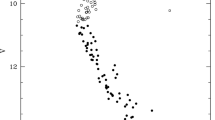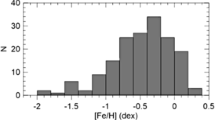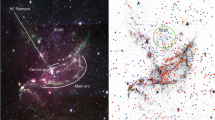Abstract
Far-ultraviolet photometry derived from the GALEX satellite observatory has been compiled for a sample of metal-poor subdwarfs with \(\mathrm{[Fe/H]} < -1.0\). The FUV properties of these subdwarfs are compared with those of a set of Population I dwarfs that are known to have low levels of chromospheric activity. Comparisons are made via a number of photometric plots, including an absolute FUV magnitude versus \((V-K_{s})\) diagram, two-colour diagrams involving both \((m_{ \mathrm{FUV}}-B)\) and \((m_{\mathrm{FUV}}-V)\) versus \(B-V\), and a two-colour diagram composed of \((m_{\mathrm{FUV}}-V)\) versus \((V-K_{s})\). The warmest subdwarfs with \((V-K_{s}) \sim1.2\mbox{--}1.4\) show FUV excesses ranging from \(\sim2\mbox{--}3~\mbox{mag}\) relative to the Population I dwarfs, with the amount of FUV enhancement decreasing among subdwarfs of decreasing effective temperature. The coolest dwarfs that are compared have \((V-K_{s}) \sim1.8\), and among these stars the subdwarfs with \(-2.0 \leq{\mathrm{[Fe/H]}} \leq-1.0\) approach the locus of low activity Population I dwarfs in the \((m_{\mathrm{FUV}}-V, V-K_{s})\) diagram. In the \((m_{\mathrm{FUV}}-B, B-V)\) diagram the subdwarfs in this metallicity range overlap the Population I dwarf sequence for \((B-V) > 0.6\). The behaviour of the subdwarfs is consistent with their FUV fluxes being determined by a combination of a photospheric FUV spectrum, the strength of which diminishes towards cooler effective temperatures, and a spectrum of emission lines arising from a chromosphere and/or transition region which are of comparable strength between the coolest dwarfs and subdwarfs.












Similar content being viewed by others
Notes
By comparison, Huang et al. (2015) calibrated a \(T_{\mathrm{eff}}\) versus \((U-V)\) relation and showed it to be more sensitive to metallicity than even the correlation between \(T_{\mathrm{eff}}\) and \((B-V)\). For example, at \((U-V) = 1.0\) dwarfs with \(\mathrm{[Fe/H]} = -2.00\) are some 1100 K cooler than dwarfs of the same \(U-V\) colour but a metallicity of \(\mathrm{[Fe/H]} = +0.25\).
Shortward of 1700 Å both the LTE and NLTE models of Allende Prieto et al. (2003) underpredict the emergent continuum flux in the solar spectrum.
References
Allende Prieto, C., Lambert, D.L.: Astron. J. 119, 2445 (2000)
Allende Prieto, C., Hubeny, I., Lambert, D.L.: Astrophys. J. 591, 1192 (2003)
Alonso, A., Arribas, S., Martinez-Roger, C.: Astron. Astrophys. 313, 873 (1996)
Ayres, T.R.: Astron. J. 149, 58 (2015)
Ayres, T.R., Simon, T., Stauffer, J.R., Stern, R.A., Pye, J.P., Brown, A.: Astrophys. J. 473, 279 (1996)
Barbuy, B.: Astron. Astrophys. 123, 1 (1983)
Barry, D.C., Cromwell, R.H., Hege, K., Schoolman, S.A.: Astrophys. J. 247, 210 (1981)
Barry, D.C., Hege, K., Cromwell, R.H.: Astrophys. J. 277, L65 (1984)
Barry, D.C., Cromwell, R.H., Hege, E.K.: Astrophys. J. 315, 264 (1987)
Beers, T.C., Sommer-Larsen, J.: Astrophys. J. Suppl. Ser. 95, 345 (1994)
Bessell, M.S., Norris, J.: Astrophys. J. 263, L29 (1982)
Blanco, C., Catalano, S., Marilli, E., Rodonò, M.: Astron. Astrophys. 33, 357 (1974)
Boesgaard, A.M., Novicki, M.C.: Astrophys. J. 633, L125 (2005)
Brott, I., Hauschildt, P.H.: In: Proceedings of the Gaia Symposium, The Three-Dimensional Universe with Gaia. ESA, SP-576, p. 565 (2005)
Brown, A.G.A., Vallenari, A., Prusti, T., et al. (Gaia Collaboration): Astron. Astrophys. 616, A1 (2018)
Cabestany, J., Vazquez, M.: Astrophys. Space Sci. 97, 151 (1983)
Camarota, L., Holberg, J.B.: Mon. Not. R. Astron. Soc. 438, 3111 (2014)
Carbon, D.F., Barbuy, B., Kraft, R.P., Friel, E.D., Suntzeff, N.B.: Publ. Astron. Soc. Pac. 99, 335 (1987)
Cardini, D., Cassatella, A.: Astrophys. J. 666, 393 (2007)
Carney, B.W.: Astrophys. J. 233, 211 (1979)
Catalano, S., Marilli, E.: Astron. Astrophys. 121, 190 (1983)
Cuntz, M., Rammacher, W., Ulmschneider, P., Musielak, Z.E., Saar, S.H.: Astrophys. J. 522, 1053 (1999)
De Medeiros, J.R., Silva, J.R.P., do Nascimento, J.D. Jr., Canto Martins, B.L., da Silva, L., Melo, C., Burnet, M.: Astron. Astrophys. 458, 895 (2006)
Dotter, A., Chaboyer, B., Jevremovoć, D., Kostov, V., Baron, E., Ferguson, J.W.: Astrophys. J. Suppl. Ser. 178, 89 (2008)
Findeisen, K., Hillenbrand, L., Soderblom, D.: Astron. J. 142, 23 (2011)
Guinan, E.F., Ribas, I., Harper, G.M.: Astrophys. J. 594, 561 (2003)
Hartmann, L.W., Noyes, R.W.: Annu. Rev. Astron. Astrophys. 25, 271 (1987)
Huang, Y., Liu, X.-W., Yuan, H.-B., Xiang, M.-S., Chen, B.-Q., Zhang, H.-W.: Mon. Not. R. Astron. Soc. 454, 2863 (2015)
Isaacson, H., Fischer, D.: Astrophys. J. 659, 725 (2010)
Keeping, E.S.: Introduction to Statistical Inference. Van Nostrand, Princeton (1962)
Laird, J.B.: Astrophys. J. Suppl. Ser. 57, 389 (1985)
Linsky, J.L., Bushinsky, R., Ayres, T., Fontenla, J., France, K.: Astrophys. J. 745, 25 (2012)
Mamajek, E.E.: The Ages of Stars. In: Proceedings of the International Astronomical Union Symposium 258, p. 375. Cambridge University Press, Cambridge (2009)
Mamajek, E.E., Hillenbrand, L.A.: Astrophys. J. 687, 1264 (2008)
Meléndez, J., Cohen, J.G.: Astrophys. J. 659, L25 (2007)
Mermilliod, J.-C., Mermilliod, M., Hauck, B.: Astron. Astrophys. Suppl. Ser. 124, 349 (1997)
Morrissey, P., et al.: Astrophys. J. 619, L7 (2005)
Norris, J., Bessell, M.S., Pickles, A.J.: Astrophys. J. Suppl. Ser. 58, 463 (1985)
Ochsenbein, F., Bauer, P., Marcout, J.: Astron. Astrophys. Suppl. Ser. 143, 23 (2000)
Pace, G., Pasquini, L.: Astron. Astrophys. 426, 1021 (2004)
Plez, B., Cohen, J.G.: Astron. Astrophys. 434, 1117 (2005)
Prusti, T., de Bruijne, J.H.J., Brown, A.G.A., et al. (Gaia Collaboration): Astron. Astrophys. 595, A1 (2016)
Ryan, S.G., Norris, J.E., Bessell, M.S.: Astron. J. 102, 303 (1991)
Simon, T., Herbig, G., Boesgaard, A.M.: Astrophys. J. 293, 551 (1985)
Skrutskie, M.F., et al.: Astron. J. 131, 1163 (2006)
Skumanich, A.: Astrophys. J. 171, 565 (1972)
Smith, G.H., Redenbaugh, A.K.: Publ. Astron. Soc. Pac. 122, 1303 (2010)
Smith, G.H., Hargrave, M., Eckholm, E.: Publ. Astron. Soc. Aust. 34, 40 (2017)
Soderblom, D.R.: Annu. Rev. Astron. Astrophys. 48, 581 (2010)
Soderblom, D.R., Duncan, D.K., Johnson, D.R.H.: Astrophys. J. 375, 722 (1991)
Thorburn, J.A.: Astrophys. J. 421, 318 (1994)
Turon, C., et al.: Hipparcos Input Catalogue, Version 2. ESA SP-1136 (1993)
Wenger, M., et al.: Astron. Astrophys. Suppl. Ser. 143, 9 (2000)
Zahnle, K.J., Walker, J.C.G.: Rev. Geophys. Space Phys. 20, 280 (1982)
Acknowledgements
The author gratefully acknowledges the support of award AST-1517791 from the National Science Foundation of the United States. Some of the data presented in this paper were obtained from the Mikulski Archive for Space Telescopes (MAST), located at the Space Telescope Science Institute (STScI). STScI is operated by the Association of Universities for Research in Astronomy, Inc., under NASA contract NAS5-26555. This publication makes use of data products from the Two Micron All Sky Survey, which is a joint project of the University of Massachusetts and the Infrared Processing and Analysis Center/California Institute of Technology, funded by the National Aeronautics and Space Administration and the National Science Foundation. This research has also made use of both the SIMBAD Astronomical Database and the VizieR catalogue access tool, operated by CDS, Strasbourg, France.
This work has made use of data from the European Space Agency (ESA) mission Gaia,Footnote 6 processed by the Gaia Data Processing and Analysis Consortium (DPAC).Footnote 7 Funding for the DPAC has been provided by national institutions, in particular the institutions participating in the Gaia Multilateral Agreement.
Author information
Authors and Affiliations
Corresponding author
Rights and permissions
About this article
Cite this article
Smith, G.H. GALEX far-ultraviolet observations of metal-poor subdwarfs. Astrophys Space Sci 363, 235 (2018). https://doi.org/10.1007/s10509-018-3455-2
Received:
Accepted:
Published:
DOI: https://doi.org/10.1007/s10509-018-3455-2




